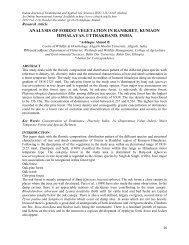COHERENT AND INCOHERENT SCATTERING CROSS ... - CIBTech
COHERENT AND INCOHERENT SCATTERING CROSS ... - CIBTech
COHERENT AND INCOHERENT SCATTERING CROSS ... - CIBTech
You also want an ePaper? Increase the reach of your titles
YUMPU automatically turns print PDFs into web optimized ePapers that Google loves.
International Journal of Physics and Mathematical Sciences ISSN: 2277-2111 (Online)<br />
An Online International Journal Available at http://www.cibtech.org/jpms.htm<br />
2011 Vol. 1 (1) October-December, pp.64-67/Kumar et al.<br />
Research Article<br />
Figure 1: The experimental set-up (not to scale). S is the source, D is the NaI(Tl) detector, C,C 1 ,C 2 ,C 3<br />
and C 4 are lead collimators, E is the lead shielding around the detectors,P1 and P2 are the scatterer<br />
positions.<br />
In the total attenuation cross section measurements usually extreme care is taken to prevent the scattered<br />
photons from reaching the detector by selecting a very small angle of acceptance (less than few minutes),<br />
whereas in the present studies the scattered photons at small angles were allowed to reach the detector by<br />
increasing the angle of acceptance of the detector by varying the distance d between the target in P2<br />
position and the detector (Figure 1). The spectrum therefore contained both the transmitted photons and<br />
the photons scattered within the angle of acceptance of the detector. In order to obtain the contribution of<br />
the scattered photons, the usual attenuation coefficient measurement set up was slightly modified and the<br />
cross sections were determined from the intensities I 1 and I 2 measured at the two scatterer positions<br />
P1and P2 (Figure 1) by using the equation<br />
I2<br />
A ln<br />
I<br />
1<br />
(<br />
0.60225 t<br />
) barn / mole<br />
The 241 Am source was procured on a loan basis from the Department of Physics, Mangalore University.<br />
Sugars of uniform thickness were used as scatterers. Their maximum thickness (mass per unit area) was<br />
chosen to be about one mean free path in order to minimize the multiple scattering (Gopal S and<br />
Sanjeevaiah (1973), Marigowda et al., (1986)). The detection system used in the present studies<br />
consisted of a scintillation head, high voltage unit, low voltage supply, linear amplifier and a multichannel<br />
analyzer. The scintillation head of the type SH 644, supplied by Electronics Corporation of India Limited<br />
(ECIL), Hyderabad, India which is built into a complete unit comprising of a scintillator, Photomultiplier<br />
and Pre-amplifier was used. The scintillator used was a thallium activated (2”X 2 ” ) sodium iodide<br />
[NaI(Tl)] crystal. The resolution of the detection system used was about 8% for the gamma rays of<br />
interest. The detector signal was further amplified by a linear amplifier and the spectrum was analyzed in<br />
a personal computer based 8K multichannel analyzer. The entire experiment was carried out in an airconditioned<br />
room wherein the mains’ voltage was stabilized.<br />
RESULTS <strong>AND</strong> DISCUSSION<br />
The total scattering cross sections obtained at the angles 4 0 – 10 0 are shown in Table 1. The experimental<br />
errors were to the extent of 3%-4%. The measured total scattering cross sections of the some sugars were<br />
found to be in agreement with the non-relativistic theoretical total scattering cross sections tabulated by<br />
Hubbell et al., (1975). Which were computed using the form factor and scattering functions based on the<br />
non-relativistic Hartree-Fock model within the range of experimental errors.<br />
65

















